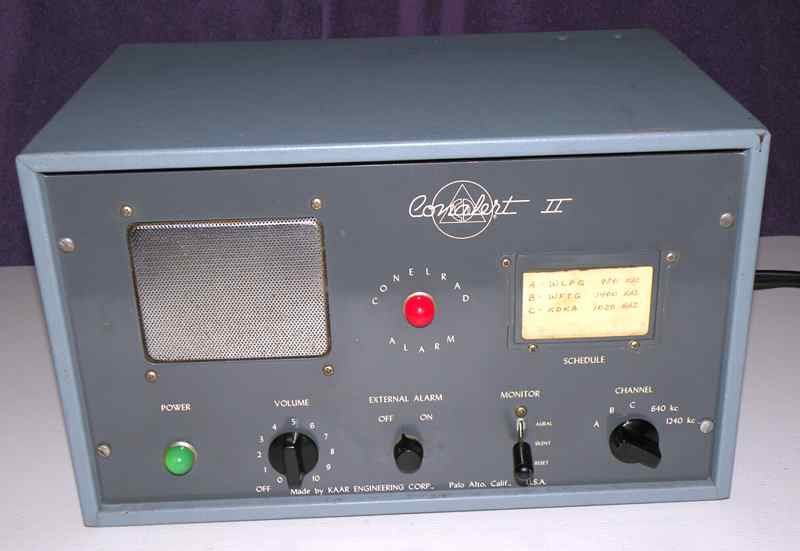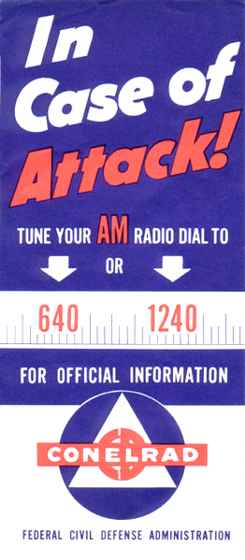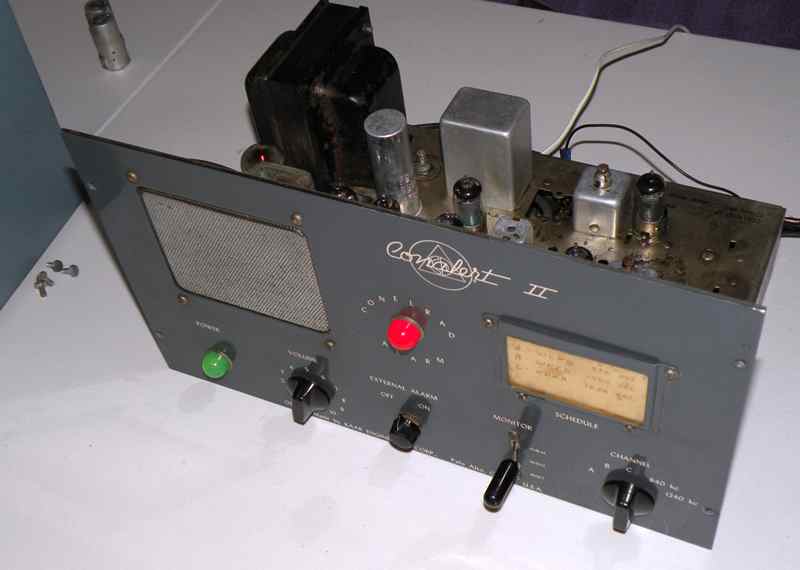
This Conalert II is a Conelrad monitor with 5 switch-selected broadcast band "channels" (tunable AM frequencies). Two of those frequencies were intended to be fixed at 640 and 1240 KHz. The Conalert was manufactured by Kaar Engineering, model number 117R906.

A Relic of the Cold War
Early in the "Cold War", there was concern that enemy bombers could simply home in on American cities by tuning in to specific broadcast radio and television transmitters. At the time, certain 50 kilowatt AM broadcast stations were still clear channel, the only stations in the nation at night on specific frequencies.

The 1951 solution to the problem was called Conelrad which stood for CONtrol of ELectronic RADiation. Conelrad was "devised to provide radio communications in a national emergency while denying enemy bombers the use of radio beams as an aid in finding targets. This is accomplished by having television and FM stations cease their regular transmissions and selected AM stations to go to either 640 or 1240 KHz."
In an alert, with broadcast stations transmitting only on either 640 or 1240 KHz, no directional aid would be available to an enemy bomber. Emergency information for the public would be broadcast on those frequencies.
Radios beginning with model year 1953 are marked with little CD triangles at 640 and 1240 on the AM broadcast dial. The CD stood for Civil Defense or Conelrad. For more information on Conelrad and subsequent systems, see
Barry Mishkind's radio history site
It was an FCC requirement
All broadcast stations and even ham radio operators were required to have a means of monitoring and to cease normal transmission in the event of a Conelrad alert. This Conalert II monitor was probably used by a commercial broadcast radio or TV station.
These monitors were designed to be on at all hours. This one was designed to be left on either the 640 or 1240 setting. The red "Conelrad Alarm" pilot light activates when the unit is first turned on. After warmup, it can be "reset" using the momentary contact bat handle switch.
If a carrier is detected in the 640 or 1240 setting, the alarm lights up. When the remote switch is in the "On" position, the 6 volts AC used by the alarm pilot light is also routed to a rear terminal strip for triggering a remote alarm or light. Remote speaker connections are also available. The three tunable settings labeled A, B, and C were typically set to larger radio stations in the area as a check to see if they were still on the air as a hedge against false triggering of the alarm. The alarm light will stay on if the channel switch is on one of those three "channels".
The Motorola Conelrad monitor that I repaired earlier works in reverse fashion. It simply monitors a carrier of choice such as another radio station. Its alarm is triggered by a tone or if the carrier for the monitored station drops out. I suspect the Conalert may be an earlier design.
Repairs
I do not have a schematic for this device. If you have the schematic, please share. The use of a wiring harness makes troubleshooting a bit difficult without one. As part of the usual safety checks, I found a fuse wrapped in aluminum foil, a problem quickly resolved. I also checked and replaced a couple of "Black Beauty" capacitors known for failure. Most of the caps in the set are ceramic which are not known for failure.
After a slow power up, the monitor would not function at all. I used a signal injector to determine what part of the set was dead. The main loss of signal was around the converter and first IF stage. A frequency counter confirmed that the local oscillator was working. Using a signal generator, I was able to pass a signal in the 450 to 500 KHz range through the second IF. I do not know the exact IF frequency for the set. My guess is a standard 455 KHz based on the offset of the local oscillator at the 640 and 1240 switch settings. Aligning both IF transformers to a sharp peak at 455 KHz finally enabled a good signal to pass through the IF stages. I suspect this monitor's IF adjustments had been tampered with. Each of the switched frequency settings has a separate trimmer cap for oscillator, RF amp, and antenna. The three tunable settings other than 640 and 1240 also have individual RF gain adjustments.

I aligned the monitor to 5 broadcast stations of interest to me. Because the 640 and 1240 "channels" are also tunable, they are now tuned to active stations near those frequencies.
The monitor has provision for both a high impedance antenna and for low impedance. A long piece of wire can be used as an antenna for the high impedance connection. I connected my 6 meter ham antenna and its coax lead-in to the low impedance connection. A low impedance external antenna pulls in stations without a lot of local noise making for a nice experience listening to favorite AM broadcasts.
Impressions of the Conalert
This is definitely a commercial piece of gear. Because the Conalert II was designed to be on 24 hours a day, 7 days a week, as necessary, the power transformer remains just warm and never hot. From the tube brands in the set, I assume that all of the tubes have been replaced at some time in the set's life indicating it likely served continuously during the ten years of Conelrad and probably much longer. The most powerful of the 3 selectible stations is penciled in as KDKA (Pittsburgh) indicating a probable service location within proximity of a good signal from KDKA.
A possible history of this Conalert
I had purchased this piece at the Dayton Hamvention. Seeing it on my website, Doug, N4YKQ speculated that the piece was likely used by the CAP (Civil Air Patrol) squadron in London, Kentucky. Two of the broadcast stations listed were from the London area. I had wondered why KDKA which was quite distant from London was on the list.
Doug added
date 4-7-09, update 2-8=15
A Cenco audio amplifier/ speaker was the previous item on the bench.